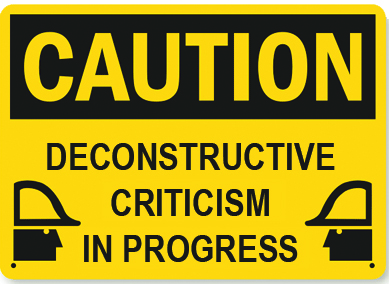Deconstruction
A reading strategy emerged as an offshoot of Poststructuralism. The literal meaning of the word is if we think that the word ‘construct’ means to put something together, then we can think of ‘deconstructing’ as taking apart that which has been built. The idea of deconstructing a text is the central practice of poststructuralist reading. It means, quite literally, what it suggests: to take the text apart. This should not be confused with the idea of criticizing a text – or destroying it. Rather, it represents a way of analysing the text by breaking it down. Thus, the central concern of deconstructive reading is to discover what is hidden or buried within a text.
Poststructuralist criticism looks for the obscured or denied meanings within the text. A text carries an alternative meaning, one that can move far beyond the boundaries of thinking eventually explore the new insights in a particular text.
The task of this kind of theoretical approach is to look for these alternative meanings – for the contradictions and inconsistencies within the text. In addition to this, a deconstructive reading can look for the silences in the text – the things that are quit unspoken.
The emphasis of deconstruction largely lies on the playfulness of language and of its inherent instability owes much to the work of the French philosopher Jacques Derrida. Practitioners of this school of analysis refuse to state a clear formula in reading texts, arguing that such a fixed formula for "application goes against the very spirit of Deconstruction. The emphasis on textuality and its layered openness also induces a sense of never-ending and dizzying (confusing) play of words .
Paradoxes, ambiguities and ambivalences in texts are brought to the surface in this reading, mainly to demonstrate that the text's stated meaning and buried meaning often contradict each other. With attention to etymology, deconstructive readings invoke the multiple meanings of words, and this proves an effective tool to dismantle the text's existing structure. Thus, deconstruction enables a collapse of the idea of a unitary, unified and the definite nature of the text.
Poststructuralism corrected the blindness of structuralism and opened the possibilities of displacing the “centre” during the analysis of a text.
Two terms closely related to deconstruction are différance and the trace. The former, coined by Derrida in an essay of the same name (1982), means both difference and deferral, playing on the two meanings of the word in French. Derrida uses it to suggest that the idea of the relationship between the signifier and signified implied by structuralism is never complete. There is always an element of deferral – of reference to other words and meanings – that causes a disruption of this process.
Différance
(Meaning is produced through difference and deferral)
In a literary text, words never convey a stable or singular meaning. Each word relies on its difference from other words, and its meaning is constantly deferred/ postponed, until we examine more words and more contexts. The result is that a text opens into an endless play of meanings.
Example T.S. Eliot’s The Waste Land
- The line “April is the cruellest month” defers its meaning:
“April” traditionally symbolizes spring and rebirth. But Eliot associates it with painful awakening and memory.
Likewise, the Derridean idea of the trace, which appears in both Writing and Difference and Of Grammatology, suggests that words are haunted by what they do not mean. This, is the trace (or track) that readers can uncover and follow to examine the complex, often contradictory, ideas that may be suggested by a text. Influenced by psychoanalysis, such traces may not be intentional but they are not accidental either – they exist, always, as what is present and yet unseen in any use of language.
Trace
(Each word contains the ghost of others, the absent elements that shape it)
In literature, a word or concept is never fully present in itself. It is shaped by the “traces” of what it excludes or has displaced. These traces remain invisible yet active, haunting the text.
Example William Blake’s The Tyger
The poem asks: “Did he who made the Lamb make thee?”
“Tyger” is defined not in isolation, but by the trace of its opposite, the Lamb, associated with innocence, gentleness, and purity.Even when not explicitly mentioned, the Lamb haunts the Tyger as its moral and spiritual counterpart. The concept of divine creation is also haunted by the trace of destruction and terror, suggesting ambiguity in divine intention.
Aporia
(A logical or interpretive impasse; undecidability within the text)
Aporia arises in texts when meaning collapses into paradox or contradiction, making clear interpretation impossible. These are not narrative flaws but moments of productive uncertainty.

No comments:
Post a Comment
looking forward your feedbacks in the comment box.